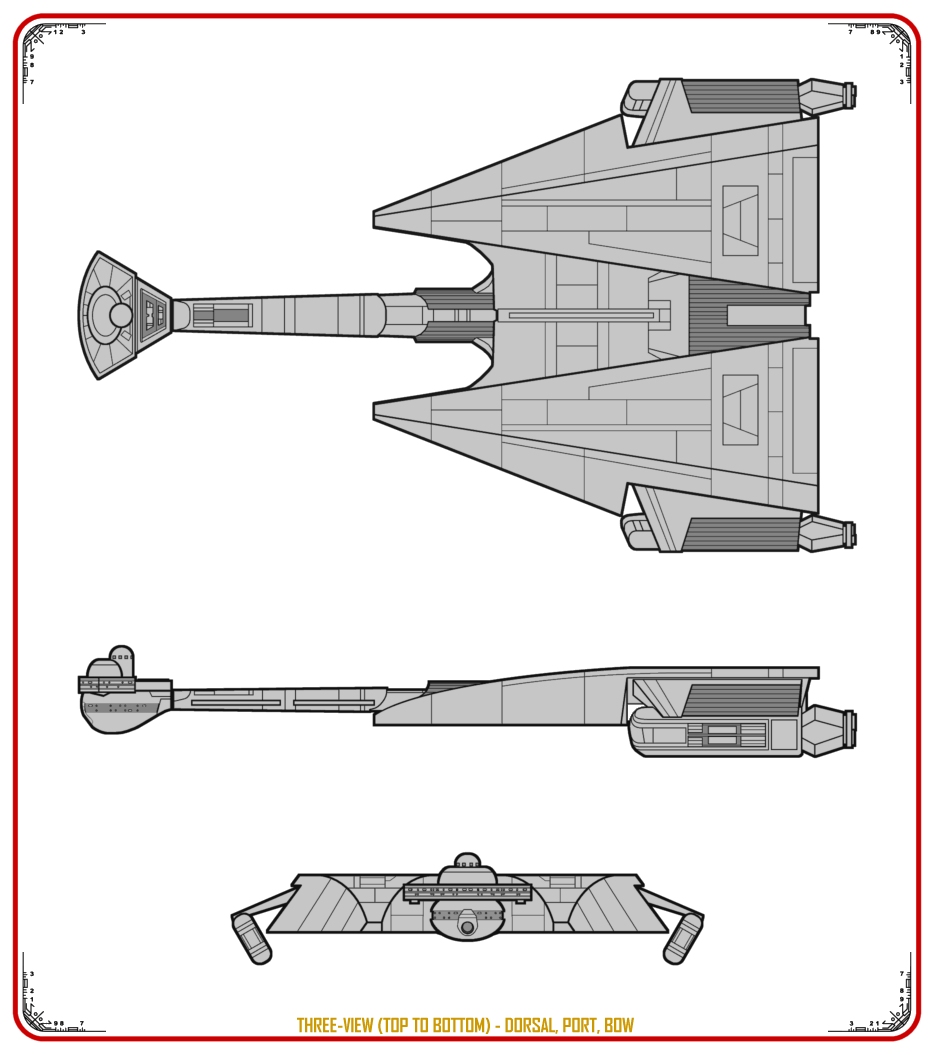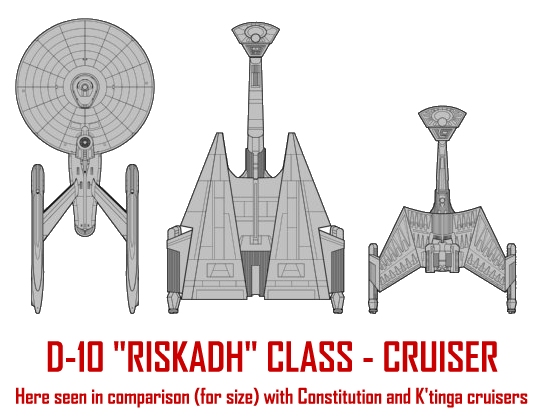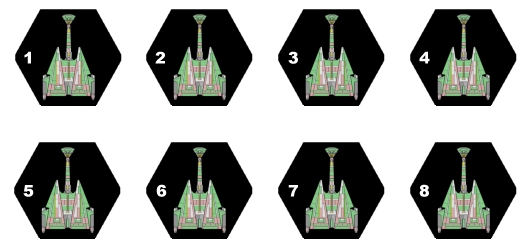|
THE RISKADH IS A VERY, VERY FUN KLINGON SHIP TO PLAY. Especially the later models, which have a decent
balance of firepower and defensive oomph. The styling of the
FASA D-10 is also
like that of the L-13 'Fat Man' in that this cruiser has a very slab-sided
ST:TOS feel to it. As always, this ship has no basis in
official Trek canon and has never been seen in any movie or series as far as I
know. Its distinctive wedge-shaped wings would make it stand out on
screen, so I don't think I've seen anything even remotely resembling the D-10 on
any of the films or on any of the series.
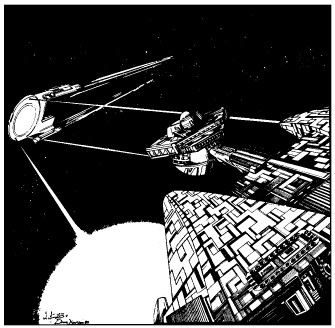 In FASA lore, this ship is
quite
storied, especially where the so-called 'Four Years War' is concerned. In
actual game use, this ship is a great match for the big Federation or Romulan
cruisers; especially later models. Packing a nice punch with powerful
torpedoes and strong superstructure, I've had a lot of success with the D-10
ship over the years. It's even more fun playing one or two Riskadh-class
ships against a host of smaller, weaker opponents, because you have to think on
your feet and use your potent weaponry wisely, otherwise you're liable to expend
all your power chasing around the smaller ships while they slowly bleed you to
death with phaser or disruptor attacks. In FASA lore, this ship is
quite
storied, especially where the so-called 'Four Years War' is concerned. In
actual game use, this ship is a great match for the big Federation or Romulan
cruisers; especially later models. Packing a nice punch with powerful
torpedoes and strong superstructure, I've had a lot of success with the D-10
ship over the years. It's even more fun playing one or two Riskadh-class
ships against a host of smaller, weaker opponents, because you have to think on
your feet and use your potent weaponry wisely, otherwise you're liable to expend
all your power chasing around the smaller ships while they slowly bleed you to
death with phaser or disruptor attacks.
In 2007 I tackled a re-draw project
wherein I attempted to clean up the FASA graphics and reconcile the D-10's
apparent size with that of the classic D-7 design. The D-10, as it
originally appears, has only two things in common with the
D-7 K'tinga: the
bridge pod, and the warp engines. Because of its ubiquitous use in Klingon
design, I opted to use the command pod as my scalar common reference, which
actually blew up the D-10 quite a bit, in terms of its silhouette, when compared
to the K'tinga. This in itself posed a certain problem, in that the D-10,
when re-sized, is approximately the same size as a
Constitution Refit,
which puts the D-10 well above the K'tinga in terms of mass. Yet, the
later model D-7 units and the D-10 units are all mass range X, according to the
FASA mass chart; something not easily explained when the K'tinga is perhaps 2/3
the size of the Riskadh, and appears to possess not nearly as much secondary
hull volume. Add to this the fact that the dimensions as given by FASA
place the D-10 and D-7 very close to one another, and it's difficult to
determine which reference point, if any, can be trusted as accurate.
In the end, I had to conclude that
the later-model D-7 units were over mass, and that the D-10 was appropriately
larger than expected; on the same order as the Constitution Refit, which is a
mass XI vessel. This would seem to be confirmed by the fact that, if we
compare a correctly-sized K'tinga, Riskadh, and Constitution refit—all in a
row—the D-10 is clearly on par with the Constitution Refit, both in terms of
size, and also in terms of weaponry and other game stats.
Surface detailing proved to be the
final dilemma, in that the D-10 has traditionally employed the blank 'slab'
aesthetic dating to TOS. I experimented with some hull etching similar to
the D-7, figuring the class could use some refined elements during a re-draw,
but ultimately decided to keep the additional detailing to a minimum; no
'feathering' or other exoticness. Thus, beyond scalar concerns, the new
Riskadh still retains 90% of the original's overall look.
— BRT

From the FASA Star Trek KLINGON SHIP RECOGNITION MANUAL, circa 1985
D-10 (Riskadh) Class VIII - X Cruiser
Known sphere Of Operation: Empire-wide use
Data Reliability: A for models A, D, and G; B for model F, D for model H.
Major Data Source: Models A, D, and G are in Star Fleet possession; Klingon
Sector Intelligence
On Stardate 1/9606, the D-10 cruiser, the design of
which was strongly influenced by the D-7, was commissioned into service. The
Klingon Imperial Command hoped to counter Star Fleet's Constitution class
cruisers with this new vessel. The Four Years War was in its second year, and
the Klingons had learned some of their lessons well. The D-10 featured a sturdy
superstructure and the most effective shields the empire had to offer. The fore
and aft-mounted disruptors were far superior to the Federation lasers, but were
not as destructive as the Federation's accelerator cannons.
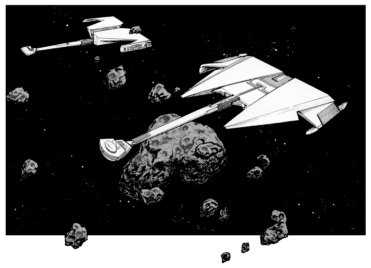 The D-10 used the same command pod as the D-7, thus eliminating the need for
additional production facilities. Like the D-7s pod, that of the D-10 is capable
of being jettisoned and has similar sub-light maneuvering and life support
capabilities. On Stardate 1/9802, Star Fleet captured a pod that had been
jettisoned during the Battle of Kesse 16 months earlier; the crew were alive and
as well as could be expected.
The D-10 used the same command pod as the D-7, thus eliminating the need for
additional production facilities. Like the D-7s pod, that of the D-10 is capable
of being jettisoned and has similar sub-light maneuvering and life support
capabilities. On Stardate 1/9802, Star Fleet captured a pod that had been
jettisoned during the Battle of Kesse 16 months earlier; the crew were alive and
as well as could be expected.
The main hull of the early D-10s contain the engineering section, shuttlebays,
crew quarters, and assault troop hypothermia capsules; later models have no
troop-carrying capabilities but instead have large research facilities. The warp
engines are mounted on short pylons and are jettisonable. With the additional
removal of the hypothermia capsules, the ship is capable of running on its
impulse power alone for up to one year. The shuttle hangars are located on the
upper wing surface of the main hull and are seen as two large doors. Directly
aft of these doors are located the aft firing disruptors; aft-firing photon
torpedo tubes are located at the stern of the vessel just below the impulse
exhaust port.
The
D-10 is the only Klingon warship whose class name honors a Klingon family line:
the Riskadh line, which died with its founder, Kahless the Unforgettable, the
greatest of all emperors. D-10s are manufactured at the Taamar, Gnuu Re', Fonawl,
Z'hai, and Mustaka facilities. The combined production rate is 14 D-10Ds, 12
D-10Gs, and 10 D-10Hs per year.
The D-10A first entered service on Stardate 1/9606, the first ships being
rapidly sent into the Four Years War, where they proved to be the most powerful
and feared ships in the Klingon Imperial Navy.
The model used a powerful warp engine, but mounted a fairly weak impulse system,
the only real shortcoming of the vessel; the main engines allowed the ships to
cruise at Warp 6, with emergency speeds as high as Warp 8. The weapons system
consisted of six individually-mounted KD-6 disruptors and two aft-mounted KD-3s,
giving the cruiser an offensive range capability 80,000 km greater than
Federation warships.
With the Klingons having range superiority, if it had not been for the superior
tactics of the Star Fleet commanders, the Four Years War might have turned out
much differently. Star Fleet commanders were able to neutralize the range
superiority in many cases, however. Klingon tactics were to send a D-10 with a
small escort of three-to six destroyers into a system to secure it. Federation
commanders would leave the system, making it appear unprotected; they would then
return from several different directions and take the unsuspecting Klingons in
flanking attacks. This tactic was not always successful, but it did deter the
Klingons from mounting many attacks into the interior of Federation space. In
the last months of the war, the Klingons faced the newly-developed phaser and
photon torpedo, and the days of the D-10 as the "Queen Of Battle" were
over.
Of the 444 D-10As built, 27 are in reserve fleets,
268 have been converted to D models and 14 to F models, 106 have been destroyed,
8 have been captured (6 by Star Fleet and 2 by the Romulans), 6 are listed as
missing, 7 have been scrapped, 6 have been sold to ranking families within the
Empire, and 2 have been sold to private interests in the Triangle.
The
first modification to the D-10 came on Stardate 2/ 1012, when the KIB-2 impulse
drive system was replaced with the KID-2. Though the new D-10B was ordered into
production, it never was produced in numbers because the KWE-2 warp drive system
was brought into the navy's inventory just as the new 8 models were ready for
installation of their warp drives. These engines were installed, and, on
Stardate 2/1201, the first D-10C was taken out for maneuver trials. On Stardate
6 2/1205, the completed ships were outfitted with the newly-created KD-9
disruptors, KP-4 photon torpedo, and the KSO shield systems, replacing the
original equipment with upgraded systems. The D-10D entered service on Star-
date 2/1307 with the simultaneous commissioning of 23 ships, the largest number
of new ships to be commissioned at one time in known space.
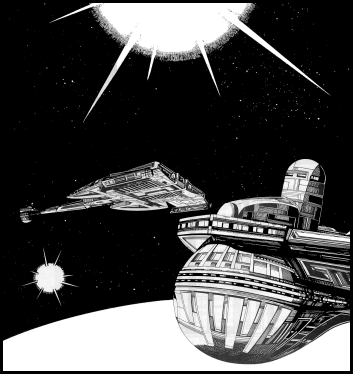 The
KWE-2 warp drive system allows the D-10D to achieve cruising speeds of Warp 7
and emergency speeds of Warp 8, even though it adds 30,000 mt to the overall
weight. The KD-9 disruptors produce slightly less damage than the KD-6 models
found on the D-10A, but they have an increased range of 20,000 km. The real
increase in weapons power lies in the KP-4 torpedo, which is mounted fore and
aft. The addition of so many new systems required an in- crease in the
superstructure strength. The
KWE-2 warp drive system allows the D-10D to achieve cruising speeds of Warp 7
and emergency speeds of Warp 8, even though it adds 30,000 mt to the overall
weight. The KD-9 disruptors produce slightly less damage than the KD-6 models
found on the D-10A, but they have an increased range of 20,000 km. The real
increase in weapons power lies in the KP-4 torpedo, which is mounted fore and
aft. The addition of so many new systems required an in- crease in the
superstructure strength.
Of
the 455 D-10Ds built, 389 remain in active service, 2 are used as training
vessels, 47 have been destroyed, 2 have been captured by Star Fleet, 6 are
listed as missing, 2 have been scrapped, I has been traded to the Romulans, 1
sold to the Orions, and 5 are in the service of ranking families of the Empire.
During
the years 2/1002 to 2/1410, the Klingons created 5 new warp drive engines, 2
impulse drive systems, 5 new disrupter types, 4 photon torpedo types, 5 shield
systems (of which 2 used a trinary powertransformer),and 2 powerful computer
systems. With all these new systems, the D-10F, incorporating many of them, was
inevitable; it was commissioned on Stardate 2/1410. The KWE-3 engines produce
10% more power, and the KIE-1 impulse drive systems produce 50% more power than
the systems installed on the D models, adding maneuverability. On Stardate
2/1312, the Klingons had acquired 14 Romulan plasma weapons of the RPL-1 type,
and these weapons also were installed on the D-10F, instead of the photon
torpedo. The KD-9 disruptors were replaced with KD-13s, increasing the range
another 20,000 km, and the aft-firing KD-3s were replaced by 2 KD-9s and 2
KD-5s. The superstructure strength was increased by 16%, and the shields were
upgraded.
After
the completion of the D-10F models, the Klingons continued to use the Z'hai
facility to construct D-10Gs, with two changes from the F model. The hypothermia
capsules were removed and the area rebuilt as a laboratory facility, allowing
the D-10G to act as a research cruiser in hostile areas where lightly-armed
ships like the D-9 could be easily destroyed or damaged if attacked while alone.
To further augment weaponry, fore and aft-firing photon torpedo bays were
installed for the KP-4 torpedo.
On
Stardate 2/2009, the D-10H was commissioned, the first model that has an
exterior change. Instead of mounting the old style command pod, the ship mounted
the command pod from the L-9 frigate, making the class easier to identify on
visual scan but a more potent adversary. This model mounts the new KIE-2 impulse
drive system, giving it more maneuvering power than most ships in either the
Romulan Navy or Star Fleet. The disruptors were all refitted to KD-1 3s, not
only to give the vessels a longer range of fire in all directions but also to
ease the maintenance chore. The photon torpedo bay was converted to fire the new
KP-6, which causes as much damage as any of those employed by Star Fleet and
twice the damage as any used by the Romulans. With this array of weapons, and
with its strengthened superstructure, the D-10H is, by far, the most powerful of
the class and also stronger than most others in space.
|


